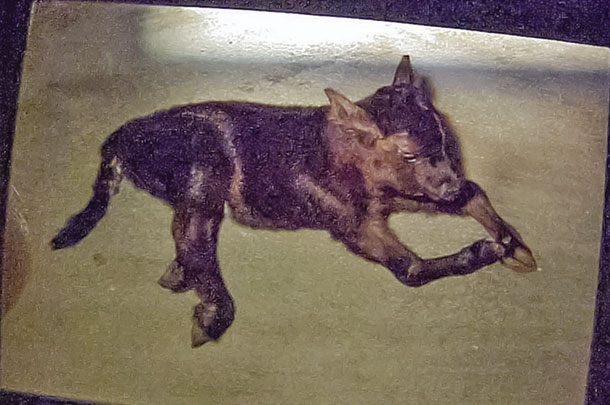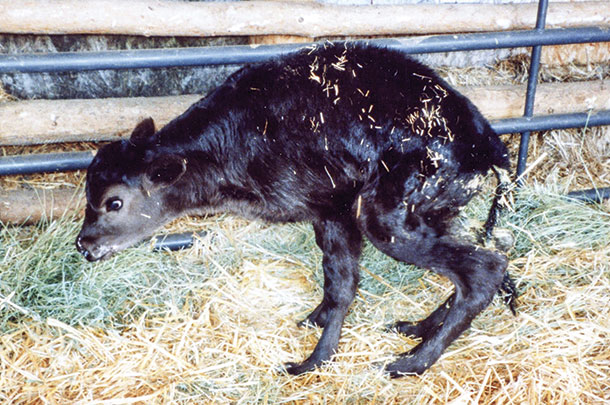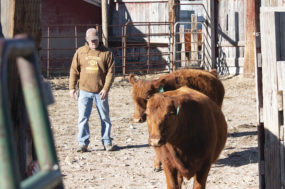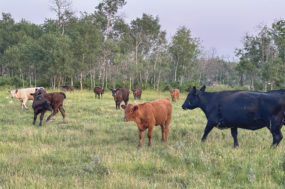But the term inbreeding refers to mating of individuals that are more closely related than the breed average – such as sire to daughter, half-siblings, sire to granddaughter, etc.
Why it’s important to prevent inbreeding
Michael Gonda of the department of animal science at South Dakota State University says there are two reasons to avoid inbreeding. “First, the more inbreeding, the more likely we’ll see calves born with abnormalities.” There is more chance they’ll receive the same genes from each parent.
 Since most animals carry a few undesirable genes (which may be recessive, requiring two copies of the gene to express that trait), doubling up genes by receiving one from each parent could result in genetic defects showing up in offspring.
Since most animals carry a few undesirable genes (which may be recessive, requiring two copies of the gene to express that trait), doubling up genes by receiving one from each parent could result in genetic defects showing up in offspring.
“The second reason to avoid inbreeding is the phenomenon called inbreeding depression – a decline in performance associated with increased levels of inbreeding,” Gonda says. This can result in lower fertility (more open cows), less hardiness and reduction in calf survivability (more calves dead at birth or shortly thereafter).
“In many cases, there is a linear relationship between the level of inbreeding and decreased performance. Not all traits are equal when it comes to the effect of inbreeding depression. It has its largest effect on traits related to fertility or survivability of the calf, whereas weight gain is only moderately affected. Carcass traits are generally affected least,” he explains.
How to prevent inbreeding
Jennifer Thomson, assistant professor of animal genetics/genomics at Montana State University, says the best way to avoid problems is to keep good records. “If you know the relationship between individuals within your herd, you can manage them accordingly. This can be a challenge, however, in multi-sire pasture breeding,” she says.
One solution is to avoid keeping a bull too long – so he doesn’t end up breeding his own daughters – or make sure his daughters are in a different breeding pasture, bred to an unrelated bull. “If you keep your older cows and young cows separate, this reduces chances for a cow to be bred to her sire.

A good bull is a major investment, and most people want to maximize that investment. By keeping the older cows and younger cows in separate groups, you can rotate bulls through and keep them longer,” Thomson says.
“The other option is crossbreeding. In some cases, this also makes it easier to identify the offspring. If you have a white-faced calf from a solid-colored cow, you know it was sired by the Hereford bull, for instance,” she says.
“Crossbreeding can keep inbreeding from accumulating in a herd, and you gain benefit from heterosis,” says Gonda. “This great tool allows you to take advantage of superior characteristics in different breeds, plus breed complementarity, heterosis, etc.”
With crossbreeding you can breed line-bred individuals from one breed to line-bred individuals of another breed.
“Use of composite cattle also reduces risk for inbreeding unless you have a closed herd of composites. In that case, you’ll see loss of heterosis over time and some increase in inbreeding depression. Inbreeding and heterosis are two sides of the same see-saw. When one increases, the other decreases,” explains Gonda.
“If you are staying within the same breed, pay close attention to bulls you are using; don’t continuously use the same family lines,” Gonda says. If you always buy bulls from the same seedstock producer, you may inadvertently have half-brothers, sons or grandsons of the same bulls. Pay attention to pedigrees.
You can avoid inbreeding if you utilize several breeding groups – if you know the parents of the cows. This is impossible, however, if cattle are bred on summer range where all cattle are pastured together.
“At home, you can create separate breeding groups,” says Thomson. “This can even be accomplished with temporary electric fencing to make sure bulls are not in the same pasture with their daughters. If there is any question about the sire of a calf, or you don’t know the sire, use parentage tests.
These are cheaper than they were in the past, now running between $9 and $12 per sample,” says Thomson. That way you can identify whose daughters are whose.
Tools breeders can utilize in assessing potential matings include online mating predictors. “Many breed associations offer these; you can get a calculation of inbreeding coefficient for a particular animal based on pedigree,” says Thomson.
“There are also electronic tools, like MateSel, which enable breeders to optimize breeding outcomes. A breeder can create mating lists of unrelated animals in their population to see what would be the best match-up for maximizing desired traits.” ![]()
PHOTO 1: One of the most successful linebreeding experiments was the creation of Line 1 cattle in the Hereford breed. Photo courtesy of Dr. Michael MacNeil.
PHOTO 2: Genetic defects, curly calf that can crop out when certain recessive genes are doubled up.
PHOTO 3: Genetic defects, fawn calf that can crop out when certain recessive genes are doubled up. Photos by Heather Thomas.
Line 1 Herefords
In some instances, herds were intentionally inbred or line-bred, such as the research project begun in 1934 at the ARS Fort Keogh Livestock and Range Research Laboratory in Miles City, Montana.
“This study with Herefords resulted in some animals that were more than 40 percent inbred. Line 1 Herefords are an example of a successful line-breeding program that was able to maintain high relationship coefficients with a common ancestor (Advance Domino 13) while keeping average inbreeding coefficients relatively low (less than 10 percent),” says Gonda.
The idea was to create inbred lines that could later be crossed with unrelated inbred lines, as a way to capture more heterosis – and produce a consistent product by crossing inbred lines within a breed.
Inbreeding vs. line-breeding
Line-breeding is simply planned inbreeding. “It’s called line-breeding when we don’t see a negative consequence. They are basically the same thing, but line-breeding generally refers to deliberately mating related animals because you are trying to concentrate specific traits,” says Thomson.
“The breeder wants to produce progeny related to an outstanding ancestor while trying to keep inbreeding coefficients low,” says Gonda. You are maximizing genes of a certain ancestor, on both sides of the pedigree, but further back than father-to-daughter mating, siblings, half-siblings or grandsire to granddaughter.
“Line-breeding is not something you’d intentionally do in a commercial herd. You can get away with it a little more in a seedstock herd – selling genetics rather than performance. If the inbreeding is higher in the purebred herd, it theoretically won’t be as detrimental because after the line-bred/inbred bull is sold off the place, he will be bred to cows that are unrelated to him,” Gonda explains.
“We usually see minimal negative impact if inbreeding is 5 to 10 percent,” says Thomson. “When animals are over 10 percent inbred is when you start to see inbreeding depression effects.” Therefore, a sire-daughter mating, or mating of siblings or sire to granddaughters, would be too much.
There are two advantages to inbreeding/line-breeding for a seedstock producer. You can identify sires that are carriers of genetic abnormalities. “This will show up if you breed those sires back to their daughters; we can identify abnormalities that we don’t yet have DNA tests for and don’t know much about,” Gonda says.
The other advantage to linebreeding is that you can increase the relationship of your animals to a genetically valuable ancestor. Stacking the genes enables the line-bred individual to transmit more characteristics than the other parent. “We call this prepotency. This can be valuable to seedstock producers who want to spread the genetics of a valuable, outstanding animal,” he explains.








